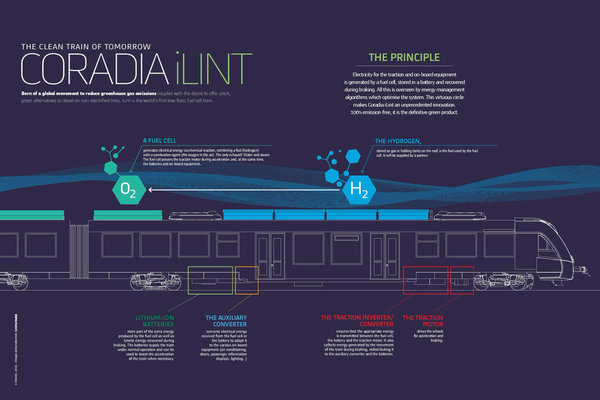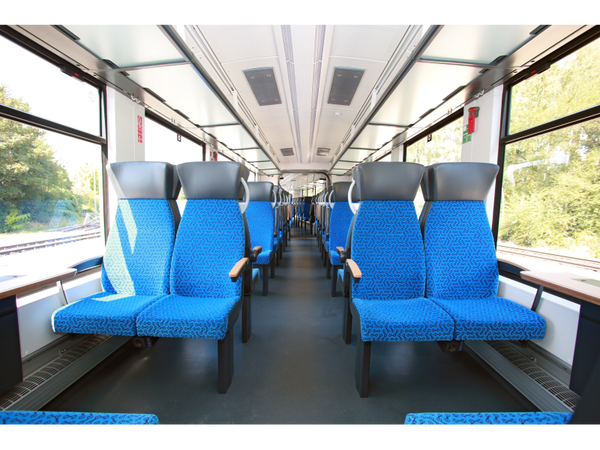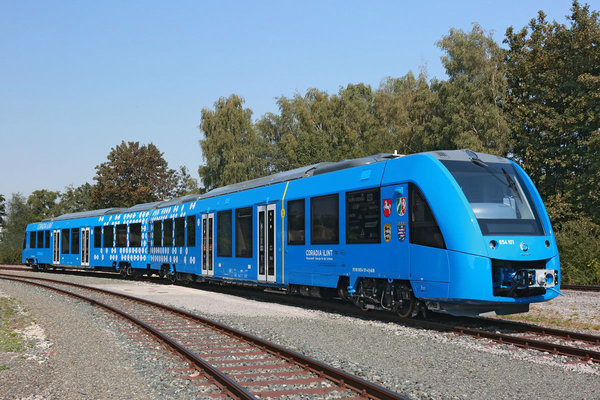The transportation industry has a massive impact on the environment, largely because it’s collectively responsible for burning most of the world’s petroleum and creating carbon dioxide emissions.
However, work is being done to improve the situation. For example, some airlines are experimenting with alternative fuels that are kinder to the environment and buses have been introduced that get energy from electricity and even biological waste. Recently, Germany was recognized for a far-out, hydrogen-powered train that could make the transportation industry even more eco-friendly.
A Rail-Travel Revolution
Last fall, French manufacturer Alstom demonstrated the Coradia iLint, a zero-emissions train that is carbon-neutral, but in a way you probably wouldn’t expect.
The train requires a hydrogen tank and a fuel cell, but the hydrogen it uses is a waste product created by the chemical industry. By relying on a substance that’s otherwise useless, the train doesn’t place an additional burden on the environment.

(c)Alstom/Michael Wittwer
Not the Fastest Train, but Fast Enough
Often, when new trains capture the headlines, it’s because they’re faster than other types of transportation. That’s not the case with the Coradia iLint, but it’s efficient enough to hold its own against competitors.
The hydrogen tank is large enough to handle journeys of nearly 500 miles and the fuel cell converts the hydrogen’s chemical energy into electricity. Unnecessary generated energy gets stored in lithium batteries underneath the train.
When going at top speed, the train reaches 116 miles per hour. It simply releases steam and condensed water into the atmosphere and is much quieter than typical diesel trains.
The First Test Run Was a Success
Alstom representatives announced the train just finished its first test run, which went well. After a trial period consisting of journeys through Germany and the Czech Republic, the train will permanently take passengers on the German Buxtehude/Bremervörde/Bremerhaven/Cuxhaven route beginning in 2018.
This project has earned the support of German transportation authorities and other cities in Germany have signed letters of intent for 60 trains in other parts of the country.

(c)Alstom/Michael Wittwer
A Solution for Other Nations Without Fully Electrified Train Lines
A spokesperson for the United Kingdom’s branch of Alstom says the Coradia iLint could be effectively used in parts of Europe that do not have fully electric rail lines. In those areas, diesel trains are still dominant, but if this hydrogen train proves feasible in Germany, it could inspire other countries to do what they can to make transportation-related gains despite not having all-electric rail routes.
There are still over 4,000 diesel train cars still running in Germany. Once it’s available for passenger travel, the Coradia iLint could show there’s a place for new technologies even in countries where diesel is the most widely used option.
The process of converting rail lines to the all-electric variety takes a long time, but engineers developed the Coradia iLint in only two years. Theoretically, it could provide transportation improvements in nations that have so far resisted making fully electric rail lines due to the time required. Then, it would disprove preconceived notions that there’s a significant time investment involved when making eco-friendly rail improvements.
China Has a Similar Technology Within Its Transportation System
A lot of negative things have been said about China’s impact on the environment due to emissions. However, that country also made news when it announced the unveiling of a hydrogen-powered tram system. The particular route for the tram has existing overhead electrical lines that serve as one power source, but the trams also have built-in hydrogen cells like the Coradia iLint.
That route is only just over five miles long. However, it’s another example of how some of the world’s nations are looking at ways to enhance transportation without completely overhauling their existing infrastructure.
The two most important things the world can learn from the Coradia iLint is that speed isn’t always the most important factor — especially when it comes to protecting the environment and future generations — and that hydrogen-powered trains could potentially make transportation more environmentally friendly, even if rail lines haven’t been updated yet.
Photo Source: Alstom.com – (c)Alstom/Michael Wittwer

This Women of Green guest blog is by Megan Ray Nichols. Megan writes about many environmental topics including, renewable energy, conservation and sustainability. She invites you to join the discussion on her own blog, Schooled By Science.
Women of Green is TURNING UP THE VOLUME of the feminine voice on the planet in order to create the world we know is possible.
